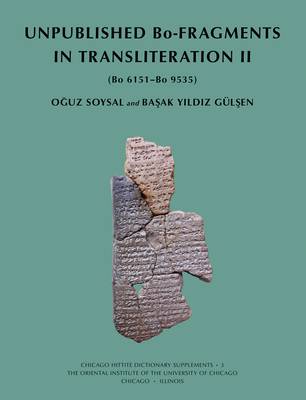
- Afhalen na 1 uur in een winkel met voorraad
- Gratis thuislevering in België vanaf € 30
- Ruim aanbod met 7 miljoen producten
- Afhalen na 1 uur in een winkel met voorraad
- Gratis thuislevering in België vanaf € 30
- Ruim aanbod met 7 miljoen producten
Zoeken
€ 74,45
+ 148 punten
Omschrijving
The monograph offers a large number of unpublished text fragments in photo and transliteration and gives succinct philological notes to these fragments. The fragments are part of a large collection that had been found during the early Turkish-German campaigns at the Hittite capital Hattusa before the Second World War. The fragments were taken to the Staatliche Museen in Berlin (which fell to Eastern Germany after the war) and were finally returned by the German Democratic Republic to Turkey (the Museum of Ancient Anatolian Civilizations, Ankara) in the year 1987. They were then divided among a team of eminent Turkish Hittitologists under the supervision of Sedat Alp, but most of the pieces remained unpublished. Following a decision of the Turkish Ministry of Culture in 2010, a new team was formed, partly consisting of members of the former team, but also supplemented by several fine younger Turkish Hittitologists. The authors of the present monograph are among these new team members. Oguz Soysal, a Hittitologist, and Basak Yildiz Gulsen, a curator of the Ankara Museum, provide photographs and transliterations of each piece. This is a very felicitous decision. Photos offer the users of his book all the information needed on the sign forms of the fragments, and the transliterations show how the authors have interpreted those signs. Wherever necessary, the authors give philological notes to explain certain forms or to present relevant text variants. Each fragment, if possible, is accompanied by information on its assignment to a Hittite text or text genre, the date of the composition, the fragment's measurements, and previous bibliography. After the presentation of the fragments highly useful indexes on onomastics and lexicographical matters close the book.
Specificaties
Betrokkenen
- Auteur(s):
- Uitgeverij:
Inhoud
- Aantal bladzijden:
- 322
- Taal:
- Engels
- Reeks:
Eigenschappen
- Productcode (EAN):
- 9781614910442
- Verschijningsdatum:
- 1/05/2019
- Uitvoering:
- Paperback
- Formaat:
- Trade paperback (VS)
- Afmetingen:
- 226 mm x 297 mm
- Gewicht:
- 1360 g

Alleen bij Standaard Boekhandel
+ 148 punten op je klantenkaart van Standaard Boekhandel
Beoordelingen
We publiceren alleen reviews die voldoen aan de voorwaarden voor reviews. Bekijk onze voorwaarden voor reviews.








